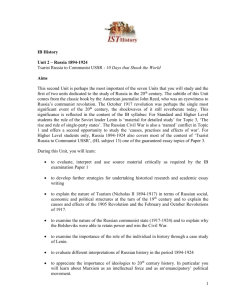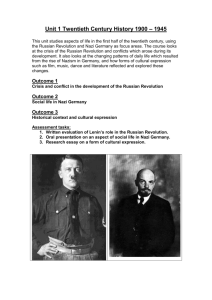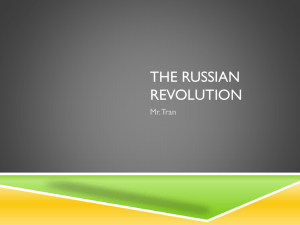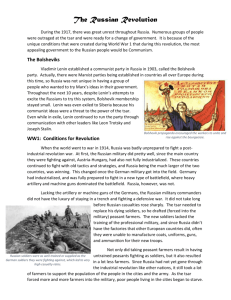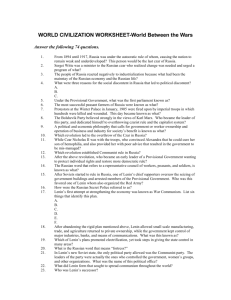Opposition to Tsardom
advertisement
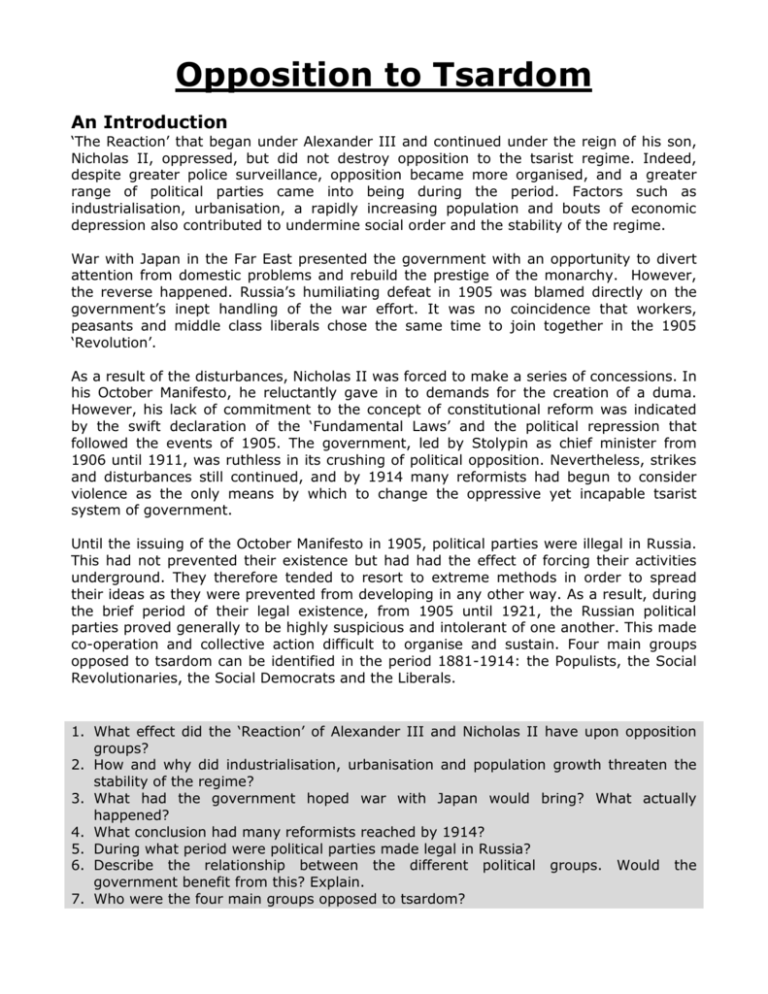
Opposition to Tsardom An Introduction ‘The Reaction’ that began under Alexander III and continued under the reign of his son, Nicholas II, oppressed, but did not destroy opposition to the tsarist regime. Indeed, despite greater police surveillance, opposition became more organised, and a greater range of political parties came into being during the period. Factors such as industrialisation, urbanisation, a rapidly increasing population and bouts of economic depression also contributed to undermine social order and the stability of the regime. War with Japan in the Far East presented the government with an opportunity to divert attention from domestic problems and rebuild the prestige of the monarchy. However, the reverse happened. Russia’s humiliating defeat in 1905 was blamed directly on the government’s inept handling of the war effort. It was no coincidence that workers, peasants and middle class liberals chose the same time to join together in the 1905 ‘Revolution’. As a result of the disturbances, Nicholas II was forced to make a series of concessions. In his October Manifesto, he reluctantly gave in to demands for the creation of a duma. However, his lack of commitment to the concept of constitutional reform was indicated by the swift declaration of the ‘Fundamental Laws’ and the political repression that followed the events of 1905. The government, led by Stolypin as chief minister from 1906 until 1911, was ruthless in its crushing of political opposition. Nevertheless, strikes and disturbances still continued, and by 1914 many reformists had begun to consider violence as the only means by which to change the oppressive yet incapable tsarist system of government. Until the issuing of the October Manifesto in 1905, political parties were illegal in Russia. This had not prevented their existence but had had the effect of forcing their activities underground. They therefore tended to resort to extreme methods in order to spread their ideas as they were prevented from developing in any other way. As a result, during the brief period of their legal existence, from 1905 until 1921, the Russian political parties proved generally to be highly suspicious and intolerant of one another. This made co-operation and collective action difficult to organise and sustain. Four main groups opposed to tsardom can be identified in the period 1881-1914: the Populists, the Social Revolutionaries, the Social Democrats and the Liberals. 1. What effect did the ‘Reaction’ of Alexander III and Nicholas II have upon opposition groups? 2. How and why did industrialisation, urbanisation and population growth threaten the stability of the regime? 3. What had the government hoped war with Japan would bring? What actually happened? 4. What conclusion had many reformists reached by 1914? 5. During what period were political parties made legal in Russia? 6. Describe the relationship between the different political groups. Would the government benefit from this? Explain. 7. Who were the four main groups opposed to tsardom? 1. The Populists Populism began in the 1870’s. It was a revolutionary movement, which believed that the future of Russia lay in the hands of the nation’s peasantry. The Populists believed that the peasants, by far Russia’s largest social group, would take the lead in transforming Russia, beginning with an overthrow of the tsarist system itself. The Populists were not members of the peasantry themselves. They were drawn, like all major political groups, from the ranks of the middle and upper classes. The Populists saw it as their duty to educate the peasants and therefore prepare them for the revolution which they would lead. This involved a policy of ‘going to the people’. Educated Populists went from universities to the countryside to live for a short time with the peasantry and attempted to incite them to revolution. However, the scheme met with little success. The peasants either did not understand, or did not accept, the revolutionary message being preached to them. In desperation, some Populists turned to terrorism, which they referred to as ‘the propaganda of the deed’, as the only way of achieving their aims. In 1879 a group called the ‘People’s Will’ was founded with the intention of murdering members of the ruling class. This group, which had no more than 400 members, was responsible for the assassination of Alexander II in 1881. However, this act of violence weakened, rather than strengthened, the movement. The importance of Populism lay in its methods rather than its ideas. Its concept of a peasant-based revolution seemed unrealistic. A highly conservative, religious and illiterate peasantry was distrustful of the educated middle classes. What was lasting about the Populist movement was the part it played in establishing a revolutionary tradition in Russia. All the revolutionaries of late nineteenth and early twentieth century Russia were influenced, if not inspired, by the example of the Populist challenge to tsardom. 1. 2. 3. 4. 5. 6. 7. 8. When did Populism begin in Russia? Why were the peasantry so important to the plans of the Populists? To what social group did members of the Populist movement belong? Explain the Populist scheme of ‘going to the people’. Why wasn’t it successful? What was the ‘propaganda of the deed’? When was the ‘People’s Will’ formed? What activities was it involved in (try to be specific) Why was a peasant-based revolution unlikely to occur in Russia? What was the lasting important of the Populist movement? 2. The Social Revolutionaries (SR’s) The Social Revolutionary Party grew directly out of the Populist movement. It extended the concept of ‘people’ beyond the peasantry to incorporate a growing urban workforce and all those wishing to see the end of the tsarist system. The SR Party was formed in 1901 with Victor Chernov as its leader. However, as with all the revolutionary groups in tsarist Russia, the SR’s were weakened by disagreements amongst themselves. There soon emerged a ‘left’ and ‘right’ wing of the party. The former were the faction who wanted to continue the policy of terror inherited from the ‘People’s Will’. The latter were the more moderate element, who, believing in revolution as their ultimate goal, were prepared to work with other parties in working for an immediate improvement in the conditions of workers and peasants. Between 1901 and 1905, it was the terrorist faction of the SR Party that dominated. During those years the SR’s were responsible for over 2000 assassinations, including Plehve, the interior minister, and the Tsar’s uncle, Grand Duke Sergei. However, the 1905 Revolution brought more gains to the liberals than the revolutionaries. One effect this had upon the SR’s was that the more moderate of its members gained greater influence over party policy. From 1906, the SR Party experienced growing support from the professional classes, from the trade unions (which had previously been banned) and the All-Russian Union of Peasants, which had been set up in 1905. At its first congress in 1906, disagreements within the Party came to a head and the left wing broke away. Chernov tried to hold the factions together, but from 1906 onwards the SR’s were a collection of radical groups rather than a genuinely co-ordinated party. 1. How did the SR Party adapt and extend the ideology of the Populists? 2. When was the SR Party formed and who was its leader? 3. Explain the disagreement that arose between the ‘left’ and ‘right’ sections of the Party. (A reasonable amount of detail will be necessary) 4. How many people were assassinated by left wing SR’s? Name some individuals that were killed. 5. What effect did the 1905 Revolution have upon the SR Party? 6. What happened at the first party congress of the SR’s? CONSIDER: HOW MUCH OF A THREAT WERE EITHER THE POPULISTS OR THE SOCIAL REVOLUTIONARIES TO THE TSARIST REGIME? 3. The Social Democrats (the SD’s) The beliefs of Karl Marx The All-Russian Social Democratic Labour Party was formed in 1898. It was a Marxist Party, which means it accepted the theories of the German revolutionary Karl Marx (1818-1883). Marx believed history was a continuous series of class struggle. He wrote that everyone belonged to one of two classes. Firstly, there were a small group of capitalists. These were people with capital (money) who built and owned the factories. They were rich and lived in luxury. Everyone else belonged to another class – the ‘proletariat’ or working class. Marx said that the workers were exploited by the factory owners to make them wealthy. They worked long hours for poor pay and would never be in a position to own anything. Marx believed that there would come a time when the workers would stand this no longer. They would unite, revolt against the capitalists and defeat them. He called this the ‘proletarian revolution’ (the revolution of the workers). After this revolution there would be no rich or poor people. The poor would take over all the land, the factories and businesses. The land would be divided up among the peasants; the factories would be run by the workers and the profits would be shared by everyone. This was Communism. Marx said that not everyone would be ready for such great change so there might have to be ‘dictatorship of the proletariat’ for a while. Leaders would issue orders while the workers were being educated. This would protect the revolution from its enemies. After a while, the workers would then run the government themselves. Then, everyone would be treated as equals. Russian Marxism Marxism appealed enormously to Russian intellectuals. They believed Marx’s theory described the changes taking place in Russian society as a result of the economic ‘Great Spurt’ of the 1890’s. A brutally-exploited, landless proletariat was emerging in Russia as part of this process of industrialisation. Russian Marxists argued that the way to ensure that the decaying tsarist regime was overthrown was to organise the workers to carry out their ‘revolution’. The first Russian Marxist was George Plekhanov. He translated Marx’s writings into Russian and formed the first Marxist organisation in the country. His efforts to promote the idea of a proletariat revolution earned him the title ‘father of Russian Marxism’. Despite this, a number of the revolutionaries who had formed the SD Party in 1898 soon became impatient with Plekhanov’s leadership. They urged him to adopt more active revolutionary policies. One such critic was a man called Vladimir Ulyanov, better known as Lenin. When Lenin returned from exile in Siberia in 1900, he set about turning the SD’s into a more revolutionary party. With a SD colleague, Julius Martov, he began a party newspaper, Iskra (the Spark), which he used to put across his viewpoint to party members. He was concerned that Plekhanov was more concerned with reform than revolution. He was worried that the SD’s were attempting to improve the conditions of workers instead of pursuing their true goal, the transformation of the workers into a revolutionary force to overthrow capitalism. Lenin wanted conditions to get worse, not better. In that way the bitterness of the industrial worker would grow, and so bring revolution nearer. The Bolshevik/Menshevik split The dispute between Plekhanov and Lenin came to a head in 1903 at the second congress of the SD Party when the issue of party membership was discussed. Lenin forced the issue and his aim was to make the SD’s choose between Plekhanov’s idea of a broad-based party, open to all revolutionaries and his own concept of a small tightly-knit and exclusive party of professional revolutionaries. A deep divide emerged between Lenin and Martov. The latter believed the former was seeking to become dictator of the party. The quarrel led to a split within the SD Party. Lenin and his supporters were called the Bolsheviks (meaning ‘majority’ which Lenin claimed he had on the issue) and Martov and his followers became known as the Mensheviks (minority). By 1912, the split had grown and the Bolsheviks and Mensheviks became two distinct and opposing Marxist parties. Lenin deliberately emphasised the difference between himself and Martov by resigning from the Iskra. A Bolshevik daily paper, Pravda, was first published in 1912. Significance of the Bolsheviks pre-revolution Whist the benefit of hindsight tells us that Lenin was ultimately successful, his significance in the pre-Revolutionary years should not be exaggerated. That he was determined and was prepared to seize the opportunity when it arose in October 1917 is clear. Nevertheless, the truth is that, during the years 1904-1917, Lenin was largely absent from Russia; his visits were rare and fleeting. Although he continued while in exile to issue a constant stream of instructions to his followers, the Bolsheviks played only a minor role in events in Russia before 1914. The 1905 revolution took them by surprise. They were not involved in its early stages and made little gain from it. The Bolsheviks also tended to be viewed by the police authorities as one of the extremist groups who were not a threat to the tsarist system. Furthermore, it is estimated that in the pre-1914 period the Bolsheviks numbered only between 5,000 and 10,000. Even in February 1917, it was no more than 25,000. Before 1917, despite their name, the Mensheviks tended to outnumber their Bolshevik rivals. 1. What was the name of Russia’s first revolutionary party and when was it formed? 2. Who was Karl Marx? Explain his theory of class struggle (this is important and needs explaining clearly and in adequate detail) 3. What was the ‘dictatorship of the proletariat’? 4. Why did Marxism appeal to Russian intellectuals? 5. Who was the first Russian Marxist? 6. Why did some members of the SD’s become critical of this man’s leadership? 7. What was Lenin’s real name? Why was he not actively involved in the revolutionary movement before 1900? 8. What was Iskra and who was responsible for it? 9. Why did Lenin not wish to see the conditions of Russian workers improve? 10.When did a spilt occur within the SD Party? 11.What was the issue that caused the split? Explain the two opposing views. 12.What were Lenin and his followers called from this time onwards? Why? 13.What were Martov and his followers called from this time onwards? Why? 14.What was Pravda? 15.How significant a role did Lenin and his party play in the years before the 1917 revolutions? CONSIDER: HOW MUCH OF A THREAT WERE THE SOCIAL DEMOCRATS TO THE TSARIST REGIME? 4. The Liberals There was never a single Liberal Party in tsarist Russia. Liberalism is a term that has been applied to describe those groups who genuinely wanted political or social change, but believed this was possible through reforming rather than destroying the tsarist system. The development of the urban economy, the educational and legal systems and public systems had generated a growing number of managers, engineers, clerks, lawyers, doctors, teachers, journalists etc. In short, a growing middle class. These people were in favour of a western-style constitutionalism. There was also a strong national element in Russian liberalism. National minorities viewed the Liberal movement as a means of expressing their wish to be independent of Russian imperial control. The two principle Liberal groups that came into prominence in the pre-1914 period were the Octobrists and the Kadets. The Octobrists This group dated from the issuing of the Tsar’s manifesto in October 1905 which set up the duma. The Octobrists were moderates who were basically loyal to the government and the Tsar. Their aims were limited. They wished to see the maintenance of the Russian Empire and were content with the establishment of the duma and the concessions contained in the manifesto. Their leading members were Guchkov, a factory owner, and Rodzianko, a large landowner. The Kadets (KD’s) The Kadet Party also came into being at the time of the 1905 Revolution. Their full title was the ‘Constitutional Democratic Party’ and they were also known as the Party of the People’s Freedom’. This was the largest group of Liberals in Russia. The Kadets wanted Russia to develop into a constitutional monarchy, in which the powers of the Tsar would be restricted by a democratically elected national assembly. In addition, the Kadets demanded full equality and civil rights for all citizens, the ending of censorship, the abolition of redemption payments on land, the recognition of trade unions and the right to strike and the introduction of universal, free education. Academics were prominent in the party - their leader was Pavel Miliukov, a professor of history. The Kadets became the major opposition voice in the first duma. 1. What does liberalism mean? 2. Which of Russia’s social groups were attracted to the ideas of liberalism? 3. Why were national minorities within the Empire attracted to liberalism? 4. When were the Octobrists formed? 5. What was the attitude of the Octobrists towards the Tsar and the government? 6. What were the aims of the Octobrists? 7. Who led the Octoberists? 8. When were the Kadets formed? What other name/s were they known by? 9. Outline the aims of the Kadets. 10.Who led the Kadets? 11.The Kadets played a major role in the first duma. Using your own knowledge explain the effect of this experience upon the strength of their party. CONSIDER: HOW MUCH OF A THREAT WERE THE LIBERALS TO THE TSARIST REGIME?




